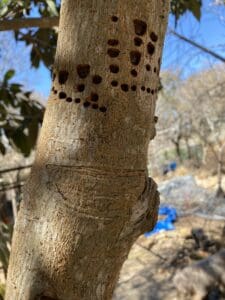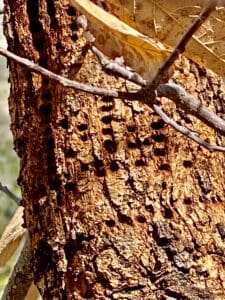What causes horizontal lines of hole in trees?
Have you seen a horizontal line of small holes on the trunk of your tree? Your tree may have been visited by a Yellow bellied Sapsucker. Sapsuckers overwinter in Central America and Southern North America, and summer in Canada and the Northern United States. Most tree damage here occurs during migration in April/May and September/October.
What damage do Sapsucker Woodpeckers do to trees?
The Sapsucker feeds on sap obtained by drilling shallow holes in a ring around a tree. Many times the trees they target are under some kind of stress already. When a tree is under stress, the sugars concentrate to provide nutrients to help fight wounds and repair injuries. Sapsuckers can apparently detect that change and target those trees.

These woodpeckers make two distinctive types of holes in trees by pecking with their pointed beaks. Round holes made by the sapsucker usually extend deep into the tree, targeting the xylem as the sap moves up the tree in the spring, as the tree leafs out. The sapsucker inserts its beak and long tongue into the hole to probe for sap. Rectangular holes are usually shallower and are used as “sapwells” that they will revisit again and again. The “sapwells” target the phloem which carries the sap down the tree once it leafs out. The Sapsuckers lick the sap from the holes and may eat portions of the cambium. When one line of “sapwells” callouses over, another ring is often made, just above the other one. The “drill holes” may encircle the entire stem. Holes made by Sapsuckers can provide points of entry for wood decaying fungi and bacteria. The cambium layer, which is responsible for producing the vascular tissues xylem and phloem, is often damaged and movement of water and carbohydrates is greatly reduced.
What can you do to protect your tree?
The best defense against these tree damaging woodpeckers is to loosely wrap hardware cloth around the trunks during the migration seasons. Another recommendation is to smear the trunk with “Tree Tanglefoot”, a petroleum product which makes it difficult for birds to land on a tree. Some recommend wrapping burlap around the trunk, but the burlap must be removed when the birds are not feeding, as leaving it on the tree can encourage insects and disease. Visual frightening devices can also be hung in the tree, but may be unsightly. Pie pans, reflective mylar, aluminum foil strips and fake owls that display movement are sometimes successful at scaring Sapsuckers away.
What can I do once the damage is done?

Once the damage is done, keeping the tree as healthy as possible by applying compost under the canopy, a light fertilization with an organic fertilizer such as MicroLife 6-2-4, and watering regularly will help the tree recover if the damage is not too severe.

Unfortunately, many times the damage is not discovered before the tree has been girdled by the Sapsucker feeding on the tree for several seasons.
Of course, it is illegal to shoot or kill a woodpecker, and studies have shown that it does little good, as new populations soon replace the old.
Interestingly, Hummingbirds depend on the “sapwells” of the sapsucker to time their migration in the spring. They often begin migration before flowers have appeared in the locations they migrate to, and the sugars from the “sapwells” will sustain them until flowers begin to appear. Both sapsuckers and hummingbirds can become quite protective of the “sapwells” they visit!
In summary, sapsuckers can be quite detrimental to trees. If you catch the damage early, you can protect your trees from further damage, but the sapsucker will most likely find another tree nearby to drill for sap. Keeping your tree healthy year-round is a great defense, as often sapsuckers target weakened trees. Just another example of ‘Mother Nature’ and humans interacting as best we can!
